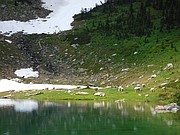FWP studies mountain goat declines
MONTE TURNER | Hagadone News Network | UPDATED 5 years, 4 months AGO
Last month, Montana Fish, Wildlife & Parks conducted a survey between Heart, Pearl and Dalton Lakes in Mineral County and 36 mountain goats were counted.
Nine of the three dozen were kids, which were born this spring, but it didn’t include the adult male billies which can be harder to locate and generally spend the summer away from the main group of nannies (female), sub-adults and kids.
“With the billies we estimate that the population is actually somewhere between 40 and 50 individuals,” said Liz Bradley, FWP Biologist for Region 2. “Every year we try to count the number of goats and age composition in the population but they are difficult to survey because they live in steep, rugged terrain and are afraid of aircraft, so they hide during aerial surveys.”
The Heart Lake group is a small native population and there used to be more along the Montana/Idaho border but many of the smaller populations blinked-out because of various reasons, including overharvest.
Goat hunting was closed in this area in 1991. There was a lot of goat hunting allowed in the 1960s and 1970s and this is the period where overharvesting too many goats without knowing it was contributing to population declines of today.
“We don’t know why some populations are declining but it seems clear that the small native herds in the west and northwest part of the state are faring worse than populations that were introduced like those around the Greater Yellowstone. Some of the introduced populations are thriving but we don’t know exactly why the native herds are not doing as well. This is a mystery,” said Bradley.
Bears, wolves and wolverines all prey on mountain goats with the kids and young adults the most vulnerable. Living in steep rocky terrain helps them avoid a lot of predation, though.
“Predation is certainly a concern, especially in small populations, and the effects of predation are going to vary depending on the herd,” Bradley said. “For Heart Lake I can say that currently I am seeing good survival of young animals and that would suggest that we’re not seeing major effects of predation right now. But we really don’t know to what extent predation contributed to some of the declines across the broader landscape of the Montana/Idaho border. Goats generally live in and around good ‘escape terrain’ - steep, rugged, rocky areas where they can get away from most predators like wolves that have to chase them down and catch them.
“Still, they can get caught away from cliffs sometimes when they’re feeding. There’s a lot of predators in the Greater Yellowstone too and yet those populations are thriving. So....it’s hard to know.”
Another possible effect on goat numbers could be climate change.
“Climate change is definitely a concern, but we just don’t know enough yet on what the impacts might be,” Bradley said. “The fact that introduced populations in Montana are thriving and native populations are declining suggests that climate change probably isn’t the main factor otherwise you would think all the populations would be affected. But we definitely might start seeing some effects and we’re trying to keep an eye out for it.”
Mountain goats have been known to eat a variety of plants such as mosses, lichens, ferns, grasses, sedges, rushes, forbes, conifers, deciduous trees and shrubs.
But they also crave salt and other minerals which has posed some challenges with campers.
“Because they are seeking salts that are found in urine and clothing, we encourage people to take their bathroom breaks at least 50 yards from trails and camping areas. The goats can be fairly bold about entering areas with people and it creates a potential safety situation,” Bradley said. “We, FWP, have been working closely with the Forest Service and the Great Burn Conservation Alliance to address the goat issues around Heart Lake. We are working on education and the Forest Service has put up an informational kiosk at Heart Lake while we explore other options to try to reduce human and goat conflicts.”
Right now is the best time to see the goats at Heart Lake. “Because the Heart Lake population is a small isolated herd, we are concerned that they could decline and disappear,” she said.
ARTICLES BY MONTE TURNER

River Edge Pavilion earns top architecture award
The Montana chapter of the American Institute of Architects is involved in numerous community outreach programs and initiatives that allow architects to give back while promoting the value of architecture to the public.

Drug dog: Mabel welcomes pharmacy customers
Customers walking into Mineral Pharmacy in Superior may be greeted by an employee who isn’t wearing a name badge, but she’s hard to miss.

Hundreds use Red Cross shelter after windstorm
The Red Cross established an emergency shelter on Wednesday night, Dec. 17, in the Superior School gymnasium after a major windstorm knocked out power across the region.



